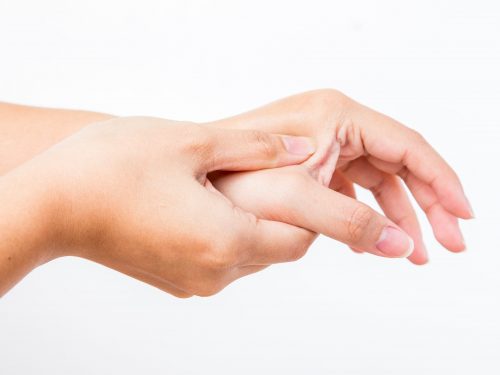De Quervain’s Tenosynovitis
De Quervain’s tenosynovitis is a condition that results from inflammation and swelling of tendons in the wrist as they run towards the base of the thumb. There may be swelling and thickening of the sheath and it becomes very painful to move the thumb. This causes movements of the thumb and wrist, such as gripping objects, to become painful. It is common in mothers who are constantly picking up and holding their children.
Treatment is needed if movement of the thumb and wrist thumb is causing discomfort or stopping you from being able to perform normal daily activities.

De Quervain’s Tenosynovitis SURGERY – facts
| Length of surgery | 45-60 minutes |
| Anaesthesia | General or regional anaesthetic |
| Hospital stay | Day case |
| Risks/complications of surgery | Frequent: Swelling, stiffness, discomfort on movement Infrequent: Infection, bleeding (haematoma), delayed wound healing, painful scar, damage to the nerve, recurrence, incomplete resolution of symptoms, complex regional pain syndrome |
| Recovery | 1-2 weeks until return to office work |
| Driving | 1-2 weeks |
| Hand position | Elevation above the heart level |
| Follow up | 1 week, 6 weeks, 3 months, 6 months |
| Duration of results | Permanent |
DOWNLOAD FURTHER INFORMATION
De Quervain's Tenosynovitis
Any hand surgery procedure is a personal choice and understandably there are a number of questions that arise. This information sheet is a general guide for patients considering De Quervain’s tenosynovitis treatment under the care of Dr Mackenzie. It should provide the answers to some questions that you may have.
What is De Quervain’s tenosynovitis?
De Quervain’s tenosynovitis is inflammation of the sheath which surrounds the two tendons that are involved in moving the thumb, called Abductor pollicis longus (APL) and Extensor pollicis longus (EPL). The tendons run through a tunnel between the wrist and the thumb. The tunnel and the tendon are covered with a layer of tissue called tenosynovium to help the tendons glide as they move through the narrow tunnel. Inflammation of the tenosynovium narrows the tunnel. There may be also swelling and thickening of the sheath and it becomes very painful to move the thumb.
Surgery involves an incision over the painful area after it has been numbed and the tight tunnel around the affected tendons is released.
What are the symptoms of De Quervain’s tenosynovitis?
Pain can appear suddenly or develop over time. Symptoms may follow a period of heavy or extensive hand use, particularly repetitive movements used at work or in a sport. They may include:
- Swelling and pain near the base of the thumb
- Movements involving the thumb and wrist such as pinching, grasping or wringing make the pain worse
- Swelling may be seen over the thumb side of the wrist
- A “catching” or “snapping” sensation may be felt when moving the thumb
- Tenderness if you press on the site of pain
- A positive Finkelstein’s test: The pain gets worse when you grasp your thumb within the palm, and you bend your wrist to the side